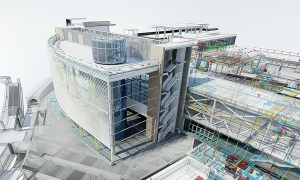Smarter Airports: Myth or Reality?
Parsons outlines how airports can improve performance and efficiencies by adopting smart technologies

Dimitris Kitsios and Paul Davies of Parsons outline how airports can improve performance and efficiencies by adopting smart technologies
What defines a smarter airport? Its people? Its processes? Its technology?
In fact, it’s all of the above. The key to a smarter airport is to have a holistic and cohesive strategy that covers all facets of the business, from procurement to maintenance to IT.
In today’s demanding travel environment, airports are constantly seeking ways to be more efficient. However, this is a challenge, with a plethora of different stakeholder groups and key operational processes that have changed only minimally but have grown more complicated. Attaining efficiency demands collaboration between systems and data sharing.
At the heart of any modern airport is the AODB, or airport operational database. The key word being data. If the business has a strategy underpinned by the integration of systems and data, efficiency will be realised. Data is truly the lifeblood of any business, and airports are no exception.
Why shouldn’t the flight schedule drive the lighting systems and public-facing screens? The schedule contains the latest information regarding passenger and aircraft movement and is best placed to manage the energy consumption required across gates and lounges to meet the most up-to-date operational plan. Any airport that wants to be considered smart must first articulate and understand its workflows and processes, then look for a technological solution that captures and enables them.
Airports face ever-increasing challenges, such as meeting accelerating capacity demands; escalating passenger demands balanced against the need for more security; rising costs; and rigid, inflexible information infrastructures. The need to do things differently – or smarter – is now an imperative. And being shrewd with business data and the integration of systems is critical to making the smarter airport a reality.
Airports of the future will be required to focus on a fast, seamless passenger experience. The industry has already made near-seamless and stress-free security screening available. Common-use self-service for passengers and luggage, Trusted Traveller programmes, advanced CT imaging at checkpoints, smart-security initiatives and biometric trails for immigration, and passenger self-boarding are all available today.
When people fly, they want to walk into an airport, drop off a bag, walk through a screening area largely unimpeded and walk out to the aircraft, ideally after eating a fresh sandwich and buying small gifts for the family. In the near future, with a fully integrated operational strategy and solution in place, this scenario will exist.
The digital transformation of airports must extend to all key aspects of operations, from air-traffic management to facilities management and runway technologies. The unprecedented capacity of systems today to analyse data in real time makes the digital transformation of airport operations not only technically feasible but also financially viable.
The requirement to be smart, however, must also stem from the way in which airports are designed and constructed. Though technology has evolved considerably in recent times, airport designs, and therefore construction projects, are often still based on traditional needs and assumptions. Instead of establishing the intelligent ethos from the beginning, often it is an aspiration that designers try to retrofit based on a client’s needs after construction has begun, which is difficult and may cause delays and cost escalation.
The early involvement of stakeholders, particularly airport operations, in the design of an airport asset is becoming imperative in conforming to the new digital reality. Construction can no longer afford to overlook IT and security until a later development stage.
So, what needs to be achieved to deliver a smarter airport? Smarter airports must abide by certain key principles:
- They must enable growth and rapid change through an intelligent and interconnected platform, ensuring flexibility and scalability.
- They must promote a collaborative environment, disseminating information in real time to all stakeholders, which will ensure a single source of truth.
- They must focus on the overall passenger experience, ensuring a predictable, repeatable and seamless end-to-end journey.
- They must encompass intelligent asset management and automation in the use of buildings and operational facilities.
- They must be environmentally friendly with smart energy management solutions.
- They must support and deliver new revenue-generating opportunities by leveraging their data and infrastructure.
As airports continue to evolve and become true mini-cities and multimodal hubs, the integration of systems, data and stakeholder needs will have to become standard practice, from design to operation, to optimise operational needs while providing an enhanced passenger experience and achieving the goal of becoming a smarter airport.

























